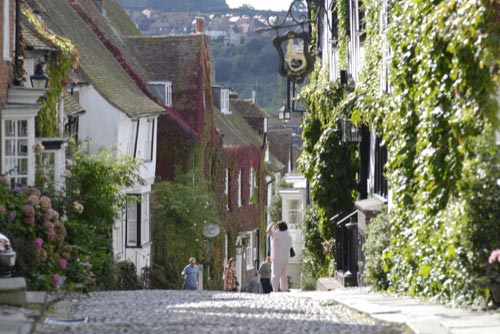
Rye’s picturesque Mermaid Street
A Medieval Town
Catch a train from London’s St. Pancras Station, and in a little over an hour, you’ll find yourself in one of England’s most ancient towns.
Rye, with its twisting, cobbled streets and medieval coaching inns, held an important position during the Middle Ages. As one of the country’s Cinque Ports, it played a key role in defending the eastern end of the English Channel from the always-pesky French. Over the years, the coast receded (it is now two miles away), leaving the town stranded, overlooking the Romney Marsh.
The fickle sea may have deserted Rye, but its charm never did. If Central Casting were to create the perfect English village, it would be this one: Cozy homes have names like Lantern Cottage, cobbled streets bear monikers like Watch Bell, and there’s a pastry shop called Simon the Pieman.
A good place to begin your exploration is the Rye Heritage Center for a look at the town model. A miniature of Rye, accurate to the last tree and shrub, it is best experienced during the 20-minute Sound and Light Show.
St. Mary’s Church is also worth a visit, mainly for its lovely churchyard; but if you have the stamina, a climb to the top of the church tower offers a panoramic vista of town and sea.
Nearby Lamb House was once home to the American writer Henry James. Now under the care of the National Trust, only a few rooms are open to the public, and hours of operation are erratic, but the garden is beautiful.
Of Rye’s four original fortified entrances, one remains: Landgate, dating to 1329. But Ypres Tower, built a century before as protection against the French, still stands and is part of Rye Museum.
The town’s most famous street is the impossibly picturesque Mermaid Street, and the most famous building on the street is the Mermaid Inn. A coaching inn since the 12th century, it gained notoriety in the 1600s as the hangout of the Hawkhurst Gang, smugglers who plied their trade in the mist-shrouded marshes along the Sussex coast.
The gang reportedly kept loaded pistols on the table as they quaffed their ale and are said to have constructed a network of tunnels from the Mermaid to the sea. As with any coaching inn worth its salt, the Mermaid is reputedly haunted, with no fewer than six of its rooms claiming a ghostly presence.
Just across the street from the Mermaid is the equally historic Jeakes House, suitable for groups of up to 15. This ivy-swathed 16th-century house originally belonged to Samuel Jeakes, whose Puritan religion once got him summoned to appear before Charles II at Whitehall in London.
There’s nothing puritanical about the lavishly appointed guest rooms, each with a unique view across the red roofs of the town toward Romney Marsh. Adding to the charm is the fact that the inn’s owners have kept all of its nooks and crannies intact.
The George Inn is located in the center of town. Dating back to 1575, the George maintains its medieval character, particularly in the drawing room with its welcoming fireplace, but has amenities to attract the 21st-century traveler as well. The pretty, flower-filled courtyard and stylish restaurant are especially appealing.
Spend some time in Rye, and you may become convinced that this is England’s best-kept secret.











